"Cherishing Little Steps - A Haven for Baby and Family Journeys"
Music and Movement for Infants
Imagine a world where music is like a gentle breeze, carrying your little one on a journey of exploration and growth. Music has the power to unlock a world of possibilities for infants, connecting them to their emotions, their bodies, and the people around them.
But it’s not just about the melodies and rhythms; it’s about the movement that accompanies the music. From swaying to the beat to clapping their tiny hands, infants thrive when they engage in music and movement together.
So, are you ready to discover the incredible benefits that music and movement can bring to your little one’s development?
Key Takeaways
- Music therapy positively impacts infant development, stimulating brain activity, language, memory, and problem-solving skills.
- Movement activities enhance coordination, motor skills, body awareness, spatial understanding, cognitive skills, sensory development, balance, and proprioception.
- Bonding through music and movement creates a sense of connection and intimacy between caregivers and infants, promoting social interaction and emotional attachment.
- Creating a musical environment with age-appropriate songs, instruments, and melodies fosters a love for music, stimulates the brain, improves memory, and enhances language skills.
The Importance of Music

Music is a powerful tool that can positively impact your infant’s development in numerous ways. One effective approach is through music therapy, which utilizes specific techniques to stimulate your baby’s senses and promote their overall well-being. Music therapy has been found to enhance cognitive, emotional, and social development in infants.
One of the key benefits of music therapy is its ability to stimulate brain activity. Studies have shown that when infants are exposed to music, it activates various areas of their brain responsible for language, memory, and problem-solving skills. This early stimulation lays a solid foundation for future learning and development.
Additionally, music therapy can help infants regulate their emotions. By listening to soothing melodies or engaging in rhythmic movements, babies learn to identify and express their feelings in a safe and enjoyable way. This can be especially beneficial for infants who may be experiencing stress or anxiety.
Furthermore, music therapy provides opportunities for social interaction. Through group music activities, infants learn to communicate, cooperate, and engage with others. This fosters a sense of belonging and promotes the development of important social skills.
Benefits of Movement

Engaging in movement activities can have numerous benefits for your infant, promoting their physical, cognitive, and emotional development. One of the key advantages of movement is improved coordination. When your baby engages in activities that involve moving their arms, legs, and body, they develop better control over their movements. This increased coordination not only helps in their physical development but also lays the foundation for future motor skills.
Furthermore, movement activities also help your infant develop body awareness. As they explore different movements, they become more aware of their own body and its capabilities. This body awareness is crucial for their overall development as it helps them understand spatial awareness, balance, and even their own limitations. By encouraging movement, you’re giving your baby the opportunity to explore and understand their own body.
Research has shown that movement activities can also have a positive impact on your infant’s cognitive development. By engaging in movement, they’re using their brain to coordinate their movements and make sense of their surroundings. This helps in the development of their cognitive skills, such as problem-solving, memory, and attention.
Sensory Development
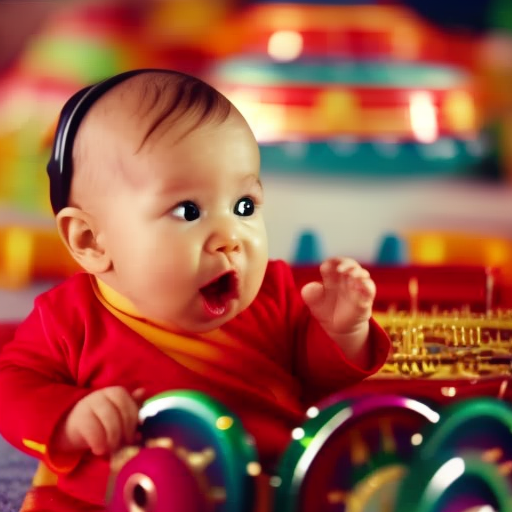
By actively participating in movement activities, your infant’s sensory development is enhanced and their understanding of the world around them expands. Sensory development is crucial for infants as they learn to explore and make sense of their environment. Through sensory exploration, infants use their senses to gather information about the world, which helps them develop important cognitive and motor skills.
Sensory integration is the process by which the brain organizes and interprets the information received from the senses. It allows infants to process and respond to sensory input effectively. By engaging in movement activities, such as dancing or playing with sensory toys, your infant is exposed to a variety of sensory experiences. This exposure promotes sensory integration as the brain learns to organize and interpret these sensory signals.
To give you a better understanding of how sensory development is enhanced through movement activities, let’s take a look at the following table:
| Sensory Experience | Movement Activity | Benefits |
|---|---|---|
| Visual stimulation | Dancing to music | Enhances visual tracking skills and depth perception |
| Tactile exploration | Playing with textured toys | Improves tactile discrimination and fine motor skills |
| Auditory stimulation | Singing and clapping | Develops auditory processing and language skills |
| Vestibular input | Swinging or rocking | Enhances balance and coordination |
| Proprioceptive feedback | Crawling or climbing | Improves body awareness and motor planning |
As you can see, each movement activity provides unique sensory experiences that contribute to your infant’s overall sensory development. So, let’s get moving and help your little one explore the world through their senses!
Bonding Through Music

Through the powerful medium of music, you can deepen your bond with your infant while simultaneously supporting their development in various sensory domains. Bonding activities that involve musical play can create a sense of connection and intimacy between you and your baby.
Engaging in musical play with your infant provides an opportunity for shared experiences and emotional connection. Singing lullabies, playing simple tunes on a toy instrument, or dancing together to rhythmic beats can create a special bond between you and your little one. These activities not only stimulate their auditory senses but also promote social interaction and communication.
Research has shown that infants who engage in musical play with their caregivers exhibit enhanced emotional bonding and attachment. The rhythmic patterns and melodic tones of music have a soothing effect on babies, promoting feelings of safety and security. Additionally, the act of singing or playing music together releases oxytocin, also known as the ‘bonding hormone,’ which further strengthens the emotional connection between you and your infant.
Furthermore, musical play provides opportunities for physical closeness and touch, which can further enhance the bonding experience. Holding your baby close while singing or dancing together creates a sense of comfort and security, fostering a deep connection between you and your little one.
Enhancing Cognitive Skills
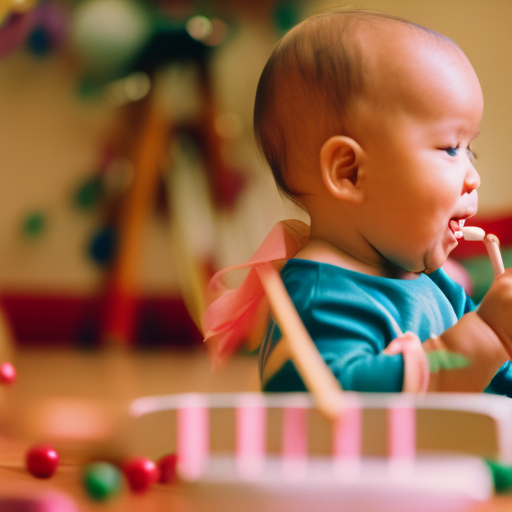
To enhance your infant’s cognitive skills, incorporating music and movement into their daily routine can have a profound impact on their development. Research suggests that exposure to music can improve memory and promote social interaction in infants. Music has a unique ability to engage multiple areas of the brain simultaneously, stimulating neural connections and enhancing cognitive function.
When you expose your infant to music, you’re creating an environment that supports memory development. The repetitive nature of songs and rhythmic patterns helps your baby store information more efficiently. As they listen and participate in musical activities, their brains create neural pathways that strengthen their memory recall abilities. This enhanced memory can have long-lasting effects on their overall cognitive development, setting the stage for future learning and academic success.
Furthermore, incorporating music and movement into your infant’s routine can promote social interaction. Singing and dancing together create opportunities for bonding and communication. When you engage in musical activities with your baby, you’re providing them with a shared experience that fosters emotional connection and social skills. These interactions not only strengthen your relationship but also lay the foundation for healthy social development in the future.
Stimulating Motor Skills
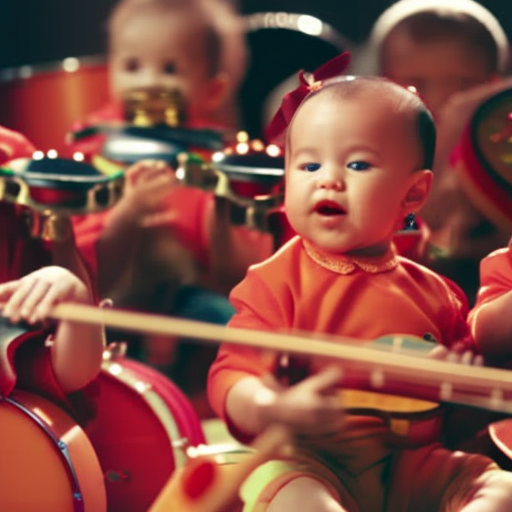
As your infant engages in music and movement activities to enhance their cognitive skills, they also receive the added benefit of stimulating their motor skills. Motor skill development is a crucial aspect of your baby’s overall growth and development. By engaging in music and movement activities, your infant can reach important motor skill milestones more efficiently.
From the moment your baby is born, they begin to develop motor skills. They start by mastering simple movements like grasping objects and kicking their legs. As they grow, they progress to more complex actions such as crawling, walking, and eventually running. By incorporating music and movement into your baby’s daily routine, you can provide them with valuable opportunities to refine and strengthen these skills.
Parental involvement plays a vital role in motor skill development. By actively participating in music and movement activities with your infant, you can help them develop coordination, balance, and spatial awareness. Engaging in activities like dancing, clapping, or playing with musical instruments can improve their fine and gross motor skills.
Additionally, providing a safe environment that encourages exploration and physical activity is essential for their overall motor development.
Choosing Age-Appropriate Songs
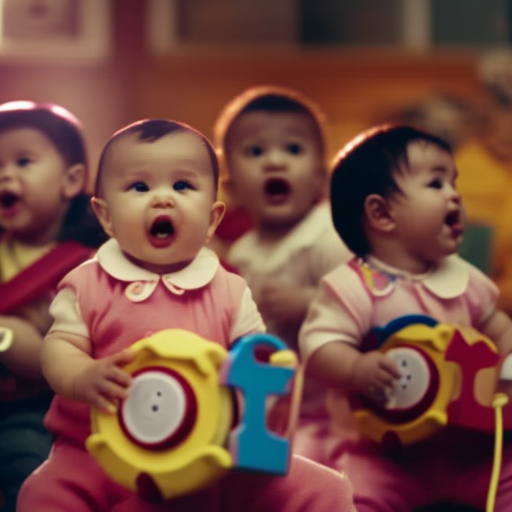
When selecting songs for your infant, it’s important to choose age-appropriate options that cater to their developmental stage. Song selection plays a crucial role in stimulating your baby’s senses and fostering their overall development.
Babies are naturally drawn to music, and research shows that exposure to music from an early age can have numerous benefits for their cognitive, emotional, and social development.
When choosing songs for your infant, it’s essential to consider their musical preferences. Babies have distinct preferences for certain types of sounds and rhythms. Generally, infants respond well to songs with simple melodies, repetitive lyrics, and a slower tempo. Nursery rhymes and lullabies are particularly popular choices for young infants, as they have a calming effect and help promote language development.
Additionally, it’s important to select songs that align with your baby’s developmental stage. For newborns, songs with gentle melodies and soothing sounds can help create a sense of security and comfort. As your baby grows, you can introduce songs with more complex rhythms and interactive elements that encourage movement and sensory exploration.
Incorporating Dance and Rhythm
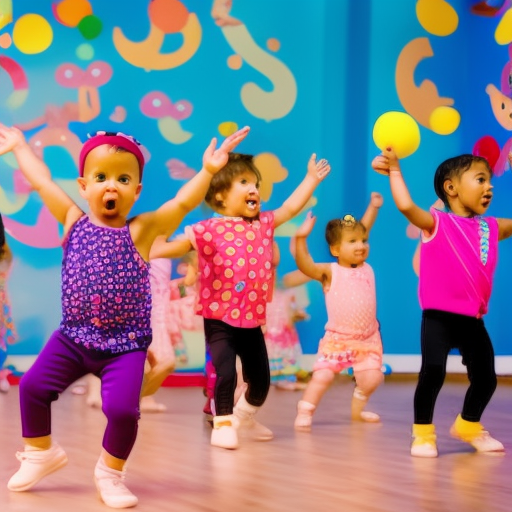
Now let’s explore how you can add a fun and interactive element to your infant’s musical experience by incorporating dance and rhythm. Dance therapy and rhythmic activities have been shown to have numerous benefits for infants, including promoting physical coordination, cognitive development, and emotional expression.
One way to incorporate dance and rhythm into your infant’s musical experience is by using simple movements and gestures while singing or playing music. For example, you can sway, bounce, or tap your hands to the beat of the music, encouraging your baby to imitate your movements. This not only enhances their motor skills but also helps them develop a sense of rhythm and timing.
Another idea is to use props such as scarves, ribbons, or shakers to engage your infant in rhythmic activities. You can encourage them to wave the scarf in time with the music or shake the shaker to the beat. These activities not only stimulate their senses but also encourage their creativity and self-expression.
Additionally, you can explore dance classes specifically designed for infants or toddler dance programs that incorporate music and movement. These classes often use age-appropriate music and introduce basic dance steps and movements that are suitable for young children.
Incorporating dance and rhythm into your infant’s musical experience can be a wonderful way to promote their overall development. So, put on some music, get moving, and enjoy the benefits of dance therapy and rhythmic activities with your little one.
Creating a Musical Environment
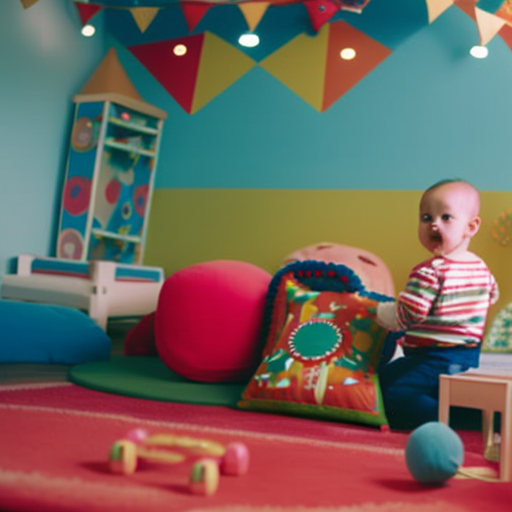
To create a musical environment for your infant, surround them with a variety of age-appropriate instruments, songs, and melodies. By doing so, you aren’t only fostering a love for music, but also promoting their early development in numerous ways.
Music has a profound impact on an infant’s cognitive, emotional, and social development. Listening to music can help stimulate their brain, improve their memory, and enhance their language skills. It also provides a channel for self-expression and communication, allowing them to connect with others on a deeper level.
When choosing instruments, opt for those that are safe and suitable for your child’s age. Soft rattles, shakers, and drums can introduce them to different sounds and rhythms. Singing songs and lullabies, accompanied by simple hand movements, can engage their senses and encourage them to explore the world around them.
Creating a musical environment doesn’t have to be limited to traditional instruments. You can also use everyday objects like pots and pans, wooden spoons, or even homemade shakers made from recycled materials. The key is to expose your child to a wide range of sounds and encourage their curiosity and creativity.
Musical Instruments for Infants
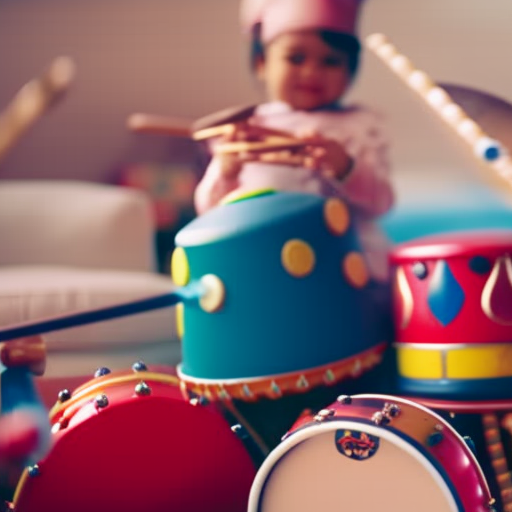
Surrounding your infant with age-appropriate instruments, songs, and melodies not only creates a musical environment but also introduces them to the exciting world of musical instruments. Introducing musical instruments at a young age can promote sensory development, enhance cognitive skills, and foster a love for music. However, it is important to prioritize your infant’s safety when selecting and using musical instruments.
To ensure musical instrument safety, it is crucial to choose instruments that are suitable for your infant’s age and developmental stage. Avoid instruments with small parts that can be a choking hazard. Opt for instruments made from non-toxic materials and ensure that they are free from sharp edges. Always supervise your infant when they are playing with musical instruments to prevent accidents.
Here is a table showcasing some age-appropriate musical instruments for infants:
| Age Group | Instruments |
|---|---|
| 0-6 months | Rattles, shakers |
| 6-12 months | Xylophones, drums |
| 12-18 months | Tambourines, maracas |
| 18-24 months | Mini keyboards, bells |
Introducing musical instruments to your infant can be a delightful experience. It allows them to explore different sounds, textures, and rhythms, stimulating their senses and creativity. So, let the music play and watch your little one’s face light up with joy and curiosity.
Music and Sleep

Introducing soothing music into your infant’s bedtime routine can promote relaxation and help facilitate a restful night’s sleep. Music therapy has been shown to have a positive impact on sleep patterns in infants. Research studies have found that playing calming music before bedtime can help regulate the body’s circadian rhythm and promote the release of melatonin, a hormone that regulates sleep.
Music has a soothing effect on the nervous system, helping to reduce stress and anxiety in infants. It can also create a comforting and familiar environment, signaling to your baby that it’s time to relax and fall asleep.
When choosing music for your infant’s sleep routine, opt for slow and gentle melodies with a rhythmic pattern. Instrumental lullabies or soft classical music can be particularly effective in promoting relaxation and sleep.
It’s important to note that every baby is unique, and what works for one may not work for another. Pay attention to your baby’s cues and adjust the music accordingly. Some infants may prefer white noise or nature sounds, while others may respond better to soft vocal lullabies.
Incorporating music into your infant’s sleep routine can have long-lasting benefits. Not only does it promote relaxation and a restful night’s sleep, but it also strengthens the bond between you and your baby, creating a sense of intimacy and security.
Music and Language Development

Music can play a significant role in supporting and enhancing an infant’s language development. The connection between music and communication is well-established, and research suggests that exposure to music can have a positive impact on a baby’s brain development.
| Music and Communication | Music and Brain Development |
|---|---|
| Helps develop listening skills | Enhances cognitive abilities |
| Facilitates language acquisition | Improves memory and attention |
| Encourages vocalization | Boosts creativity and imagination |
| Enhances social interaction | Supports emotional development |
Listening to music exposes infants to different sounds, rhythms, and melodies, which helps develop their listening skills. This exposure also facilitates language acquisition by exposing them to various speech patterns and phonemes. Additionally, music encourages vocalization, as babies often try to mimic the sounds they hear.
Studies have shown that music has a positive impact on brain development. It enhances cognitive abilities such as memory and attention, which are important for language processing. Furthermore, engaging with music stimulates creativity and imagination, allowing infants to explore different ways of expressing themselves.
Moreover, music promotes social interaction, as infants often engage in musical activities with caregivers and peers. This interaction fosters communication skills and strengthens the bond between the infant and their caregivers.
Frequently Asked Questions
What Are Some Tips for Introducing Music and Movement to Infants With Special Needs?
Here are some tips for you to adapt music and movement for infants with special needs. Create a sensory friendly environment by using soothing sounds, gentle movements, and soft lighting. Encourage engagement through visual cues and repetitive motions.
Are There Any Specific Techniques or Exercises That Can Help Promote Sensory Development Through Music and Movement?
To promote sensory development through music and movement, try incorporating rhythmic movements. These types of movements can help with sensory integration, allowing infants to explore and engage with their environment in a meaningful way.
How Can Music and Movement Activities Benefit Infants With Developmental Delays or Disabilities?
Music and movement activities can provide sensory integration and therapeutic benefits for infants with developmental delays or disabilities. By engaging in these activities, you can help stimulate their senses and support their overall development in a fun and interactive way.
Are There Any Recommended Resources or Programs for Parents or Caregivers Interested in Incorporating Music and Movement Into Their Daily Routines With Infants?
If you’re interested in incorporating music and movement into your daily routines with infants, there are recommended resources and programs available. These can help you create engaging and developmental experiences for your little one.
Can Music and Movement Activities Help With Soothing or Calming Infants Who Have Difficulty Sleeping?
Are you struggling to calm your little one to sleep? Music and movement activities can work wonders! Picture this: soothing lullabies and gentle swaying, creating a peaceful atmosphere that lulls your baby into a deep, peaceful slumber. It’s the ultimate sleep improvement technique!
Conclusion
In conclusion, music and movement play a vital role in the development of infants. They not only enhance sensory and cognitive skills but also strengthen the bond between parents and their little ones. Creating a musical environment and introducing musical instruments can further stimulate their growth.
Additionally, music has been found to aid in sleep and language development. So, don’t miss out on the incredible benefits that music and movement can bring to your infant’s life. Start exploring the world of music with them today!


